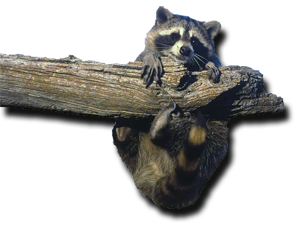
Raccoons
Raccoons
JOB DESCRIPTION:
The removal of raccoons involves an inspection of the building to identify the entry area being used by the animals. In the spring, steps are taken to ensure that any young are removed with the adults. Separating a mother raccoon from her young can cause hundreds to thousands of dollars in costly repairs to roof and soffit areas. In some cases, costly odour problems will result by removing a mother from the area or den site without removing her babies. Wild Things uses a special one-way door that simply allows the animal to exit the building while preventing re-entry. Any young are placed outside the door in a heat release box. The mother will then locate them and relocate her babies to a new area. A deodorizing machine is then used to neutralize odours from their urine and feces. If left untreated, it will attract other wildlife to your house to attempt entry. The entry holes are then animal proofed/repaired to prevent the problem from re-occuring.
WORDS FROM WILD THINGS:
Raccoons are the most intelligent animals that we deal with on a day-to-day basis. Humans have not even manufactured a garbage can that these animals cannot figure out. This is why, when we do any work to remove raccoons, we are constantly looking for the next possible problem area.
DAMAGE:
Raccoons can cause many different types of damage, resulting in costly expenses to the homeowner. The most common forms of damage are as follows:
- Damage to wiring resulting in flickering lights, failed receptacles, and electrical fires
- Water damage as a result of a hole in the roof of a building, or a damaged roof vent.
- Damage to the insulation from the raccoon packing it down and displacing it
- Odour and staining as a result of urine and feces
CONCERNS & DISEASES:
Raccoon Round Worm: (Baylisascaris Procyonis) this disease is passed from animal to animal, including humans, by ingesting or inhalation of raccoon feces. The eggs then hatch, and the larvae migrate to the brain, eyes, spine, and other organs. This disease can cause death depending on the amount of eggs that have been ingested or inhaled. There is no treatment for this parasite in humans but there are several for treating infected raccoons.
Raccoon Rabies: Rabies is a virus that attacks the central nervous system of warm blooded mammals. The most common animals infected are foxes, skunks, bats, and raccoons. Rabies is spread through saliva most commonly through bites. It may also be contracted by being licked or scratched by an infected animal. Once signs of rabies start to appear the chances of survival are less than 20%. This makes it a good idea to keep your pets vaccinations up to date. It is also recommended for humans to be immunized if they work with a number of animals on a regular basis.
BENEFITS:
To some, raccoons may not seem beneficial, but they do actually keep some other animals and insect population in check. For example, raccoons eat the grubs in the lawn, and in some cases saving the lawn itself. They also eat young squirrels and birds, keeping populations down.
LITTLE KNOWN FACTS:
- Another name for raccoon is Procyon Lotor, or “washer bear” this is because they prefer to wash or moisten their food before eating it
- Raccoons can live up to age 21 in captivity
- Raccoons can have anywhere from 1-12 young
- They are capable of making over 100 vocal sounds
- They are also capable of weighing over 50 lbs
